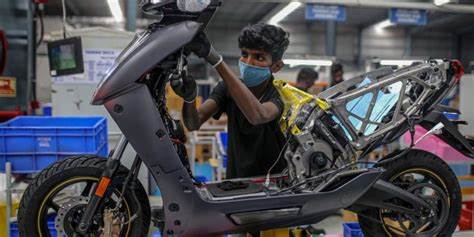A new scooter every 90 seconds. India’s EV revolution has begun

A new scooter every 90 seconds. India’s EV revolution has begun
In Hosur, a southern Indian city located near Bangalore, a startup factory is a hub of frenetic activity. The assembly line is abuzz with lightning-fast operations, where workers donning black uniforms are diligently producing a new electric scooter every 90 seconds. Executives within the company are meticulously tracking the remarkable surge in sales.
Tarun Mehta, a figure within the startup, observes this electric evolution closely. He notes that the trend towards electric vehicles is gaining tremendous momentum, particularly within the realm of two-wheelers. The pace of innovation and adoption is nothing short of extraordinary.

The startup factory’s high-paced production, together with the surge in electric vehicle sales, underscores the transformative impact that electric mobility is having on the automotive industry in India. As the demand for eco-friendly transportation options accelerates, innovative startups are stepping up to meet this demand, revolutionizing the way vehicles are produced and consumed.
Tarun Mehta, a 33-year-old visionary, holds the role of CEO at Ather Energy, a prominent electric scooter manufacturer that has been experiencing a remarkable surge in demand. Looking back, just three years ago, the company’s sales hovered around 200 units per month. However, Mehta proudly shares that today, the company effortlessly surpasses the milestone of selling approximately 15,000 units each month.
The rapid acceleration in demand for Ather Energy’s electric scooters showcases the company’s impressive growth trajectory. The skyrocketing sales are a testament to the increasing popularity of electric vehicles and the substantial shift towards sustainable transportation solutions.
As the demand for greener alternatives to traditional vehicles intensifies, Ather Energy is emblematic of the transformative impact that forward-thinking electric mobility companies can have on the automotive landscape.
The electrification of India’s expansive personal vehicle market paints a transformative picture, poised to evolve into a $100 billion industry by 2030. This process is particularly evident in a country with the world’s highest population, where two and three-wheelers take center stage, outnumbering traditional cars by approximately fourfold.
Walking down the streets of prominent cities like New Delhi or Bangalore offers firsthand evidence of this evolution. Electric mopeds, which can be acquired for as little as $1,000, zip through congested roads, presenting a viable alternative to traditional gasoline-powered vehicles. These electric options are heralded by both environmental advocates and the government as a means to alleviate the toxic smog that frequently blankets cities across India.
In the past three years alone, registrations for electric vehicles have soared by more than tenfold nationwide, underscoring the swift shift towards electric mobility. Even in the bustling Indian capital, the once-familiar colorful rickshaws, traditionally powered by human pedaling, have now transitioned to battery power, efficiently ferrying passengers throughout the urban landscape.
This profound transformation underscores India’s ambitious endeavor to reshape its transportation sector, focusing on sustainable and cleaner alternatives that align with environmental goals. The proliferation of electric vehicles not only contributes to reducing pollution but also reflects the global trend towards greener mobility solutions.
Prominent players in the industry, including Hero MotoCorp, recognized as the world’s largest manufacturer of two-wheelers, have made significant investments towards electrifying their product lineup. This move aligns with the overarching trend seen across various nations, where the transition towards sustainable transportation options is a top priority.
In India’s pursuit of sustainability, there’s a determined race towards embracing electric mobility. The national goal is to achieve a remarkable target: electric vehicles (EVs) comprising a third of all private car sales and a staggering 80% of two- and three-wheeler sales by the end of the current decade. This ambitious aspiration aims not only to address environmental concerns but also to serve as a role model for other developing nations.
However, this journey towards electric mobility is not without its challenges. Several significant obstacles need to be surmounted to achieve these goals. One critical challenge involves the need to lower the prices of electric vehicles, making them more accessible to a broader population. Additionally, there’s a pressing need to enhance the infrastructure supporting electric mobility, such as charging stations and other facilities.
As India strives to pave the way for a greener future, these challenges serve as vital focal points that require strategic solutions and collaborative efforts. Overcoming these hurdles would not only accelerate the country’s progress towards its ambitious goals but also inspire and guide other nations grappling with similar transitions towards sustainable transportation.



